Permanent Makeup vs Tattoo: Ink and Cosmetic Differences
In the world of body art and beauty, the distinction between permanent makeup and tattoos often blurs. Understanding these differences in ink, technique, and purpose is essential for anyone considering either option. As we delve into the nuances of permanent makeup versus tattoos, we will explore what sets them apart and how each can be a unique form of expression.
Understanding Tattoo and Permanent Makeup
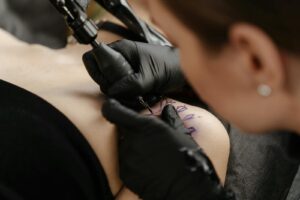
Photo by cottonbro studio on Pexels
Both tattoos and permanent makeup serve as forms of body art, yet they are fundamentally different in their application and purpose. A tattoo typically involves the insertion of traditional tattoo ink into the dermis using a tattoo machine, creating permanent designs that can celebrate individuality or commemorate significant life events. This body art often showcases intricate designs, symbols, or personal messages.
What is a Tattoo?
A tattoo is a form of body art that uses regular tattoo ink, which consists of pigment particles suspended in a carrier solution. This ink is injected into the dermis, the layer of skin beneath the epidermis, ensuring longevity. Traditional tattoos can be created in various styles and colors, with tattoo artists employing techniques such as rotary or coil machines to achieve the desired effects. Over time, tattoos may fade due to sun exposure or skin regeneration, yet they remain a permanent fixture on the skin.
Defining Permanent Makeup
Permanent makeup, or PMU, is a cosmetic procedure that involves the application of specialized pigments designed for use on the face. This semi-permanent makeup technique often includes enhancements such as eyebrow tattoos, lip tattoos, and eyeliner tattoos. Permanent makeup pigments are formulated to be safe for facial application and are designed to fade over time, typically lasting several years before touch-ups are necessary. Unlike traditional tattoos, which are primarily artistic, permanent makeup focuses on enhancing natural beauty and convenience.
Comparing the Two: Permanent Makeup vs Tattoo
When comparing permanent makeup and tattoos, several key differences emerge. The type of pigment used plays a significant role; while tattoos utilize regular tattoo ink for bold, vibrant designs, permanent makeup employs specially formulated pigments that are softer and more natural in appearance. Additionally, the techniques differ, with permanent makeup artists using precise strokes, such as those seen in microblading for eyebrows, to create realistic looks. Understanding these distinctions can help individuals make informed choices about their body art and beauty enhancements.
Ink and Pigments Used
Difference Between Tattoo Ink and Permanent Makeup Ink
The difference between permanent makeup and tattoo ink lies primarily in their formulation and intended use. Traditional tattoo ink, or regular tattoo ink, is designed for bold, long-lasting colors that penetrate deeply into the dermis. In contrast, permanent makeup ink, often referred to as
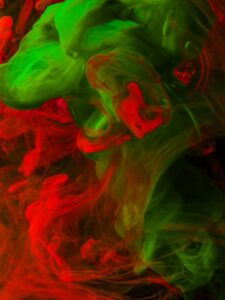
Photo by engin akyurt on Unsplash
, is formulated to create subtle, natural effects on the face. These pigments are designed to fade over time, allowing for adjustments and touch-ups, which is essential for maintaining the appearance of semi-permanent makeup. Understanding these distinctions helps individuals choose the right option for their beauty needs.
Exploring Tattoo Pigment vs Permanent Makeup Pigments
Tattoo pigments and permanent makeup pigments serve different purposes and exhibit unique characteristics. While tattoo pigments are made to deliver vibrant colors and withstand the test of time, PMU pigments are softer and designed to mimic natural skin tones. This difference is crucial when considering applications such as eyebrow tattoos, lip tattoos, or eyeliner tattoos. The tattoo artist must select the right type of pigment used for each procedure, ensuring the results enhance the client’s natural beauty while offering a long-lasting yet adjustable solution.
Types of Pigments Used in Permanent Makeup
There are various types of pigments used in permanent makeup, each specifically crafted for different applications. These include organic, inorganic, and hybrid pigments, which provide a range of shades and finishes suitable for cosmetic tattoos. Permanent makeup artists carefully choose the appropriate pigment based on the desired effect and the area of application, whether it be for the eyebrows, lips, or eyes. Understanding the different types of pigments ensures a tailored approach to beauty and a successful transformation.
Application Techniques
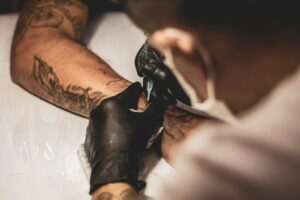
Photo by Lucas Lenzi on Unsplash
Regular Tattoo Techniques
Regular tattoo techniques involve using a tattoo machine to inject traditional tattoo ink into the dermis. Artists typically employ rotary or coil machines, which allow for precise control over the depth and speed of ink application. The skill of the tattoo artist plays a significant role in creating intricate designs, ensuring that the tattoo not only looks stunning but also heals well. Understanding these techniques can provide insight into how body art is crafted and the level of artistry involved in achieving long-lasting designs.
Methods of Applying Permanent Makeup
The methods of applying permanent makeup differ significantly from traditional tattoo techniques. Permanent makeup artists focus on creating natural-looking enhancements through meticulous application methods, such as microblading for eyebrows and machine techniques for eyeliner and lip tattoos. These methods require a steady hand and an eye for detail, as the objective is to replicate the natural appearance of makeup while ensuring longevity. Each stroke is carefully considered, resulting in a flawless finish that enhances the individual’s features.
Differences in Tools and Equipment
There are notable differences in the tools and equipment used for tattoos and permanent makeup. Tattoo artists typically utilize a tattoo machine equipped for injecting regular tattoo ink deeply into the skin, while permanent makeup artists use specialized tools designed for precise application of softer PMU pigments. These tools may include handheld devices or digital machines that cater specifically to cosmetic procedures. Understanding these differences can help individuals appreciate the skill and technology involved in both tattooing and permanent makeup, leading to more informed choices.
Longevity and Maintenance
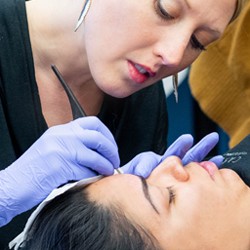
How Long Do Tattoos Last?
Tattoos are designed to be permanent, lasting for many years due to the deep insertion of regular tattoo ink into the dermis. However, factors such as sun exposure, skin type, and body care can influence how well a tattoo maintains its vibrancy over time. Many individuals find that certain tattoos may start to fade, necessitating touch-ups to preserve their original beauty. Understanding the longevity of tattoos can help potential clients make informed decisions regarding their body art and the potential need for ongoing maintenance.
Understanding Semi-Permanent Makeup
Semi-permanent makeup, often referred to as permanent makeup, is designed to enhance natural features while offering the convenience of long-lasting results. Unlike traditional tattoos, which use regular tattoo ink, semi-permanent makeup utilizes PMU pigments that are specifically formulated for facial application. These pigments gently fade over time, allowing for adjustments and touch-ups every few years. This characteristic makes semi-permanent makeup an excellent option for those seeking a low-maintenance beauty routine without the commitment of permanent tattoos.
Maintenance for Permanent Makeup vs Regular Tattoos
Maintaining permanent makeup differs significantly from caring for regular tattoos. While traditional tattoos may only require occasional touch-ups, permanent makeup often necessitates more frequent upkeep due to its semi-permanent nature. PMU artists recommend regular assessments to ensure that the cosmetic tattoo retains its intended look. In contrast, tattoos may require less frequent maintenance, although they can fade and lose their luster over the years. Understanding these maintenance requirements is essential for anyone considering either form of body art.
Health and Safety Considerations
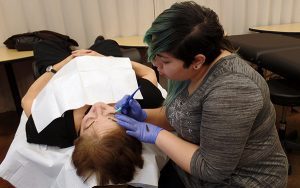
Potential Risks of Tattoos
While tattoos are often seen as a form of personal expression, they do come with potential health risks. The process of using a tattoo machine to inject ink can lead to allergic reactions, infections, or complications if proper hygiene practices are not followed. Additionally, the long-term effects of ink on the skin are still being studied. It is crucial for individuals to be aware of these risks and choose a reputable tattoo artist who prioritizes safety and sanitation to minimize any negative outcomes associated with body art.
Safety in Permanent Makeup Procedures
Permanent makeup procedures, though generally safe, also carry certain risks that should not be overlooked. Ensuring that the artist uses sterile equipment and adheres to strict hygiene protocols is vital for preventing infections and complications. Additionally, clients should discuss any allergies or sensitivities before undergoing procedures like eyebrow tattoos or lip tattoos. By prioritizing safety and choosing experienced permanent makeup artists, individuals can enjoy the benefits of semi-permanent makeup while minimizing health concerns.
Comparing Health Risks: Permanent Makeup and Tattoo
When comparing health risks between permanent makeup and tattoos, both share common concerns, including potential allergic reactions and infections. However, the difference between permanent makeup and traditional tattoos lies in the pigments used. Permanent makeup pigments are often formulated specifically for facial application, reducing the risk of adverse reactions. Understanding these distinctions can help clients make informed choices about their body art, ensuring that their experiences are both beautiful and safe.

